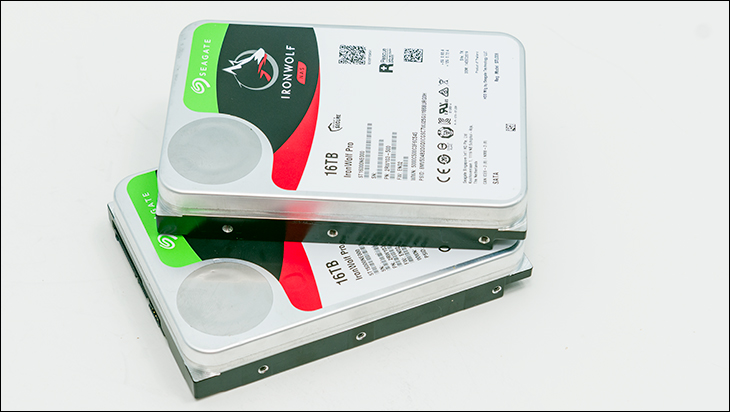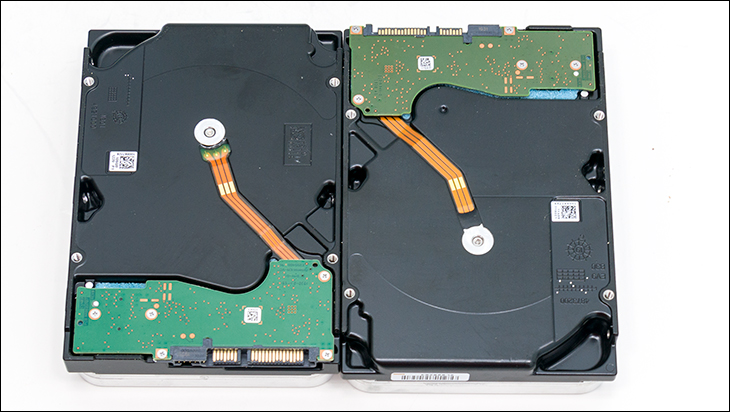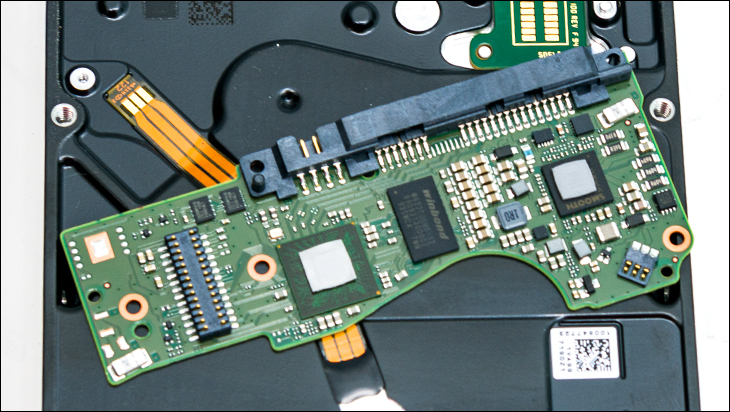
As our sample is not the retail version, we cannot comment on the shipping container that the IronWolf will come in. Based on past experience however, Seagate does usually combine a slick shipping container with plenty of information that goes over what a specific model is intended to offer. As such it should be easy to figure out if the IronWolf Pro is right for your needs or not.
As expected, the exterior chassis of the Pro variant of the IronWolf series is robust and thick to say the least. These drives are meant for heavy duty use in environments that are unforgiving and the chassis is designed to that high standard. With that said, the Pro variant’s chassis is not noticeably different from the standard IronWolf. Both are laser welded, both use a two-tone color scheme of black and silver, both use a small PCB for the external electronics… and with the exception of the ‘Pro’ addition the labels are even the same. This is because Seagate basically created one chassis for their high capacity models and re-uses it on their cheaper models. This is not a bad thing as fitting nine ~1.8TB platters into a standard 3.5-inch form-factor is tough enough without trying to figure out ways to keep costs down.
For those who have not kept up to date on advancements in Helium and PMR (Perpendicular Magnetic Recording… aka CMR or “conventional magnetic recording” which is the newer less ‘ambiguous’ term) technology, how they were able to stack the platters so close together really does boil down to using a less dense medium for said platters to spin in. To be precise this reduced medium creates less ‘suction’ or ‘drag’ on the spinning platters and significantly reduces the chances of a platter bending down and slamming into a platter below it. Basically, as the platters spin they create eddies in the ‘air’ around, over, and under them. These higher and lower pressure zones are a “bad thing” as they can cause the platters to bend. With Helium the differences in pressure is not great enough to bend the platters all that much. This is why Seagate can stack them closer together and yet be assured that they will not ‘touch’ each other under normal operating conditions (which when it happens usually shatters the platters and kills the hard drive in a rather catastrophic – and memorable – manner).
In all likelihood Seagate is also using a variation on ‘spoilers’ to further reduce the safe distance between platters (and further break up/reduce the eddies in the Helium medium)… but are being mum on precisely how they do the low level magic needed to have nine platters in such close proximity. They are however confident enough that the IronWolf Pro (just like the EXOS line) get a full five-year warranty instead of three – like the standard IronWolf 16TB comes with.

This brings us to the biggest difference between the standard and Pro IronWolf models: their durability. The standard IronWolf series is meant for use in 8 drive bay or less NAS/SAN devices, whereas the IronWolf Pro is good for 24 bay models (or less). Creating a drive that can handle the stress of 8 drives stacked in close proximity is a cake walk compared to doing it for 24 drives. Yes, the standard IronWolf has vibration reduction sensors on the PCB just like the Pro model… but the algorithms and overall abilities of the standard IronWolf are inferior. They just do not have to be all that good to deal with 8 drives worth of vibrations. The IronWolf Pro on the other hand does, and it is not only smarter at handling potential damaging vibrations but is much more aggressive in compensating for them. Even in 8 bay or less storage servers / Network Attached Storage devices / NAS appliances / etc. the IronWolf Pro will simply be able to handle random and transient vibrations better.

Yes, both models come with both ends of their spindles attached (aka dual plane balancing). Yes, both have the same 3.0/2.8 bels noise ratings. Yes, both have factory testing done before they leave the factory floor. Yes, both the standard and pro variants also come with the same max unrecoverable read error rating of a single bit error per 10E15 bits (aka 1.110223025 Petabytes) read… aka 78.125 full drives worth of reads on a 16TB HDD before you will see a single unrecoverable bit read error.
However, the IronWolf Pro (thanks in big part to more aggressive vibration compensation as well as a more Enterprise levels OCD during the build stages) is more robust and actually quieter. With both a Pro and standard sitting on our desk (please do not do this at home) the Pro was noticeably less ‘rumbly’ and creates less vibrations in the first place… and did so while also being higher performance. They also undergo more extensive factory QA/QC testing before being shipped out the door.

These low-level improvements are why the Pro comes with a higher (66.67 percent higher to be precise) workload rating of 300TB a year, and a longer (20 percent to be precise) Mean Time Between Failure rating of 1.2M hours vs 1M hours for the standard IronWolf 16TB. Does any of this matter when talking about one, two or even eight drives in a single system? Probably not… but for less than a decent order at Starbucks it is cheap “peace of mind”.
Before we move on, do not get the wrong impression. The IronWolf Pro is not built to the same standards, nor uses the same uber high quality components as the EXOS series. Instead it is better to consider the IronWolf Pro more of an Exos ‘lite’ model than prosumer / entry business line model like the standard IronWolf. Even just a quick scan of the specs will tell you this – unlimited numbers of drivers per system, whopping 550TB work load rating, etc. Though in many ways what really separates them for storage enthusiasts, besides the Exos having a lower AFR (a 0.35% vs the Pro’s 0.73%), is how they handle caching. The Exos uses a write-through policy where the data is written to both its onboard cache and the platters at the same time… but only confirms it has written the data when both concurrent writes are completed. The IronWolf series uses a write-back policy, where the data is written first to the cache and then the platters… but sends out the I/O confirmation when the cache write is completed – not the platter’s write operation. The IronWolf way is pretty typical outside Enterprise scenarios as it reduces latency and can give the appearance of faster write performance, but is less secure… as in the case of unexpected power loss that data ‘confirmed’ to be written can be lost.

Moving on. Both IronWolf and IronWolf Pro use nine ~1.8TB per platters backstopped by PMR+ with TDMR (Two-Dimensional Magnetic Recording ) technology. There probably are some low-level differences between the two (and probably how the Pro can have higher performance specs) but not enough to say conclusively. In either case, Seagate is mum on it. The benefits of PMR+ with TDMR technology is multi-fold. Firstly, by using multiple read heads per reader uncorrectable read error rates are held in check (remember the bit size at this density level are tiny… so tiny classical PMR r/w head configurations would not work without constantly throwing errors). This is because instead of one read head there are two per side of the platter (for a total of 36 in the 16TB IronWolf model). More importantly the two heads are slightly offset with one read head over the central track being read and partially over the track ‘above’ it, and the second read head offset so it is mainly on the central track and the one ‘below’ it. This allows for a more sensitive read on a given bit, easily allows for eliminating the interference from the bits surrounding the actual bit being read, and generally improves the signal to noise ratio. It also gives the drive controller two chances of reading the bit properly for a single pass.

The second benefit is performance. Instead of the r/w head being directly connected to the main controller (and raw data being piped from one end of the bus to the other). With PMR+ each TDMR head has its own controller connected to it. This ‘man in the middle’ controller is called a ‘detector’ and its job is to take the raw data streams from each read head, filter out noise, decide what is a 1 or 0, and then pass this already worked over data upstream to the main controller. This may sound like as slower proposition but it allows the main controller to free up a lot of cycles for I/O commands and heavy duty ECC. Which in turn boosts overall performance… even if it does require a lot more components and increases build difficulty.
Overall the IronWolf Pro 16TB is a rather incredible value considering it now only costs slightly more than the standard IronWolf 16TB and noticeably less than an Exos X16.











